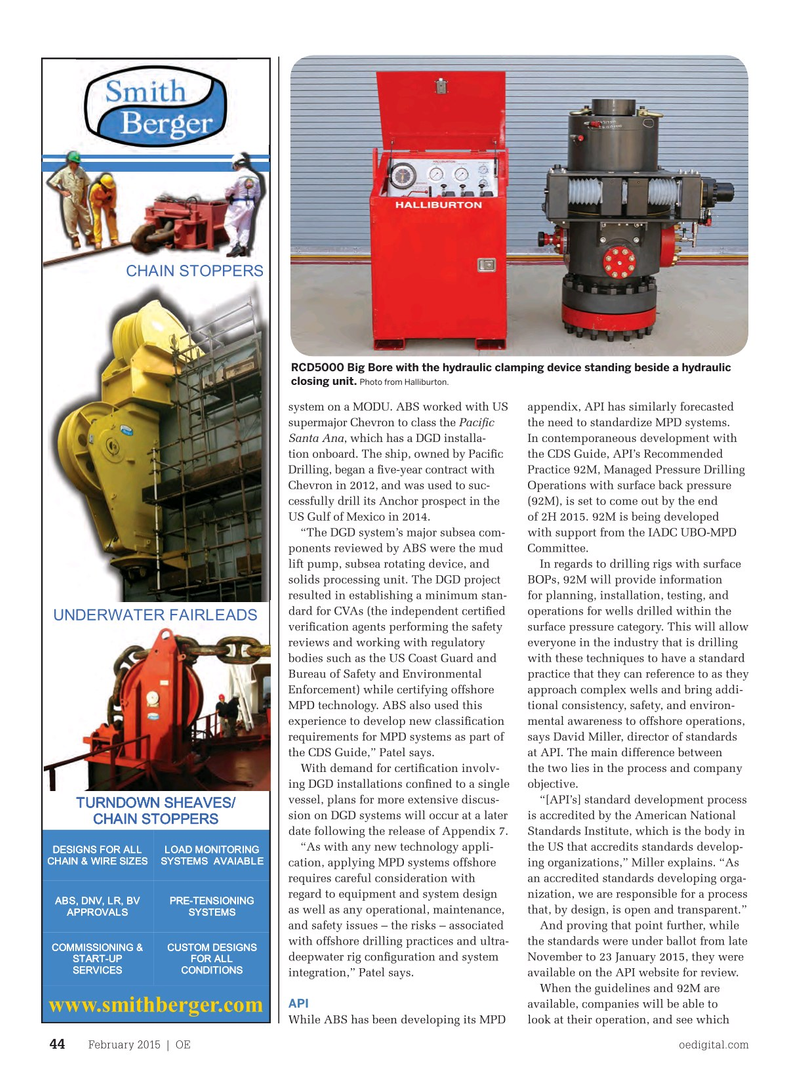
Page 42: of Offshore Engineer Magazine (Feb/Mar 2015)
Read this page in Pdf, Flash or Html5 edition of Feb/Mar 2015 Offshore Engineer Magazine
CHAIN STOPPERS CHAIN STOPPERS
RCD5000 Big Bore with the hydraulic clamping device standing beside a hydraulic closing unit. Photo from Halliburton.
system on a MODU. ABS worked with US appendix, API has similarly forecasted supermajor Chevron to class the Paci? c the need to standardize MPD systems.
Santa Ana, which has a DGD installa- In contemporaneous development with tion onboard. The ship, owned by Paci? c the CDS Guide, API’s Recommended
Drilling, began a ? ve-year contract with Practice 92M, Managed Pressure Drilling
Chevron in 2012, and was used to suc- Operations with surface back pressure cessfully drill its Anchor prospect in the (92M), is set to come out by the end
US Gulf of Mexico in 2014. of 2H 2015. 92M is being developed “The DGD system’s major subsea com- with support from the IADC UBO-MPD ponents reviewed by ABS were the mud Committee.
lift pump, subsea rotating device, and In regards to drilling rigs with surface solids processing unit. The DGD project BOPs, 92M will provide information resulted in establishing a minimum stan- for planning, installation, testing, and dard for CVAs (the independent certi? ed operations for wells drilled within the
UNDERWATER FAIRLEADS UNDERWATER FAIRLEADS veri? cation agents performing the safety surface pressure category. This will allow reviews and working with regulatory everyone in the industry that is drilling bodies such as the US Coast Guard and with these techniques to have a standard
Bureau of Safety and Environmental practice that they can reference to as they
Enforcement) while certifying offshore approach complex wells and bring addi-
MPD technology. ABS also used this tional consistency, safety, and environ- experience to develop new classi? cation mental awareness to offshore operations, requirements for MPD systems as part of says David Miller, director of standards the CDS Guide,” Patel says. at API. The main difference between
With demand for certi? cation involv- the two lies in the process and company ing DGD installations con? ned to a single objective. vessel, plans for more extensive discus- “[API’s] standard development process
TURNDOWN SHEAVES/ sion on DGD systems will occur at a later is accredited by the American National
CHAIN STOPPERS date following the release of Appendix 7. Standards Institute, which is the body in “As with any new technology appli- the US that accredits standards develop-
DESIGNS FOR ALL LOAD MONITORING
CHAIN & WIRE SIZES SYSTEMS AVAIABLE cation, applying MPD systems offshore ing organizations,” Miller explains. “As requires careful consideration with an accredited standards developing orga- regard to equipment and system design nization, we are responsible for a process
ABS, DNV, LR, BV PRE-TENSIONING as well as any operational, maintenance, that, by design, is open and transparent.”
APPROVALS SYSTEMS and safety issues – the risks – associated And proving that point further, while with offshore drilling practices and ultra- the standards were under ballot from late
COMMISSIONING & CUSTOM DESIGNS deepwater rig con? guration and system November to 23 January 2015, they were
START-UP FOR ALL
SERVICES CONDITIONS integration,” Patel says. available on the API website for review.
When the guidelines and 92M are
API available, companies will be able to www.smithberger.com
While ABS has been developing its MPD look at their operation, and see which
February 2015 | OE oedigital.com 44 042_OE0215_D&C1_Jerry.indd 44 1/20/15 6:25 PM

 41
41

 43
43